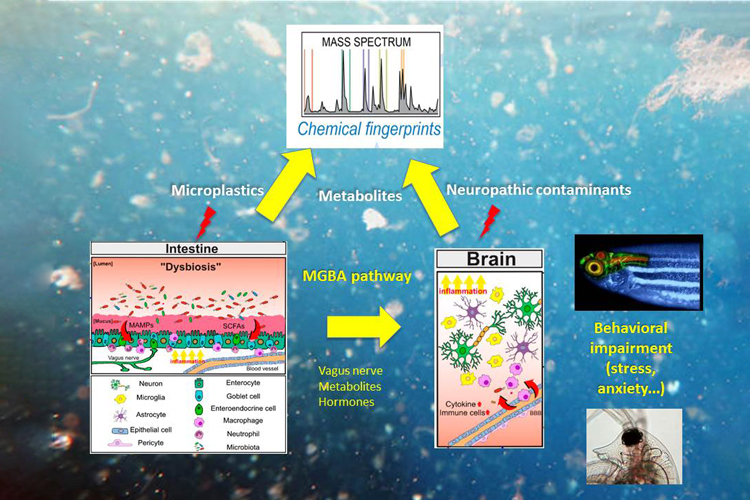Researchers from IQS and IDAEA-CSIC collaborate in this project for the analysis of neurotoxic compounds present in water, using advanced methodologies that improve the detection of these compounds and the characterisation of their risk.

Living beings, including humans, are routinely exposed to compounds that are classified as neuroactive and/or neurotoxic, some of which have been linked to neurodegenerative diseases such as Alzheimer's or Parkinson's disease. Among these compounds can be found certain drugs (serotonin inhibitors, benzodiazepines, etc.), neurotoxins, pesticides, and neuroendocrine disruptors, as well as persistent chemicals such as PCBs, PCFs, and microplastics. The final destination of all these compounds is usually aquatic ecosystems.
Due to this situation, the European Chemicals Agency (ECHA) and the United States Environmental Protection Agency (EPA), as well as other regulatory bodies, have recently proposed the use of new approach methodologies (NAMs) that provide support to decisions concerning the use of these chemicals. These new methodologies range from in silico approaches to in vitro and in vivo tests with invertebrates or vertebrate embryos (such as tests with Daphnia magna or zebrafish embryos). Moreover, the proposals include new analysis tools (genomic, proteomic, and metabolomic) considering that it is only possible to detect a small fraction of the toxins present in surface waters with the standard analysis procedures.
Within this context, COGNIRISK has been launched, a multidisciplinary project that combines toxicology with knowledge and experience in monitoring chemical agents. IQS is an active participant in this project, led by Dr Cristian Gómez with the Department of Analytical and Applied Chemistry, an expert in water analysis, metabolomics, chemometrics, and multivariate analysis, alongside Dr Carlos Barata and Dr Demetrio Raldúa, experts in environmental toxicology with the Institute of Environmental Assessment and Water Studies (IDAEA-CSIC). These two groups have collaborated in this field of research for several years1, 2, 3 ,4.
A disruptive methodology for the analysis and control of neurotoxins
COGNIRISK is funded by the Ministry of Science and Innovation's National Research Agency under the "Challenges for society" call for proposals within the Challenge 5 category: Climate change and the use of natural resources and raw materials.
The project's main objectives are threefold: first, to analyse and characterize the "chemical fingerprints" present in the samples (IQS); second, to characterize the toxicological fingerprints using omic and behavioural responses (IDAEA); and third, to compare the two previous points using multivariate methods (IQS/IDAEA).
As such, COGNIRISK is subdivided into two subprojects:
- COGNITOX, which is focused on the development and application of behaviour-based methodologies to identify dangerous cognitive effects produced by neuroactive chemical products present in water, coordinated by researchers from IDAEA-CSIC.
- COGNICHEM, which is focused on the development and implementation of analyses for the determination of neuroactive chemical products in water and their metabolomic effects on aquatic organisms, coordinated by researchers from IQS.
The working hypothesis is that the combined use of non-targeted chemical analysis, together with refined, precise, and high-throughput assays for the evaluation of neurobehavioral effects in Daphnia magna and zebrafish, will make it possible to address complex adverse effects produced by chemical contaminants (known and unknown) present in our surface waters. As proof of concept, this disruptive methodology will be used to analyse two methods of action that cannot easily be addressed with traditional methods: (1) effects in adults resulting from exposure during early developmental stages and (2) neurobehavioural effects due to alterations to the intestinal microbiota through the microbiota-gut-brain axis.
_________________________________________________________________________________________________________________________
1Bellot, M., Faria, M., Gómez-Canela, C., Raldúa, D., Barata, C. Pharmacological modulation of behaviour, serotonin and dopamine levels in daphnia magna exposed to the monoamine oxidase inhibitor deprenyl. Toxics. 2021, 9(8), 187.
2Faria M., Prats E., Bellot M., Gómez-Canela C., Raldúa D. Pharmacological modulation of serotonin levels in zebrafish larvae: Lessons for identifying environmental neurotoxicants targeting the serotonergic system. Toxics. 2021, 9 (62021), 118.
3Bellot, M., Bartolomé, H., Faria, M., Gómez-Canela, C., Raldúa, D. Differential modulation of the central and peripheral monoaminergic neurochemicals by deprenyl in Zebrafish Larvae. Toxics. 2021, 9 (62021),116.
4Bedrossiantz, J., Martínez-Jerónimo, F., Bellot, M., Raldua, D., Gómez-Canela, C., Barata, C. (2020) A high-throughput assay for screening environmental pollutants and drugs impairing predator avoidance in Daphnia magna. Science of the Total Environment, 740, 2020, 140045.













